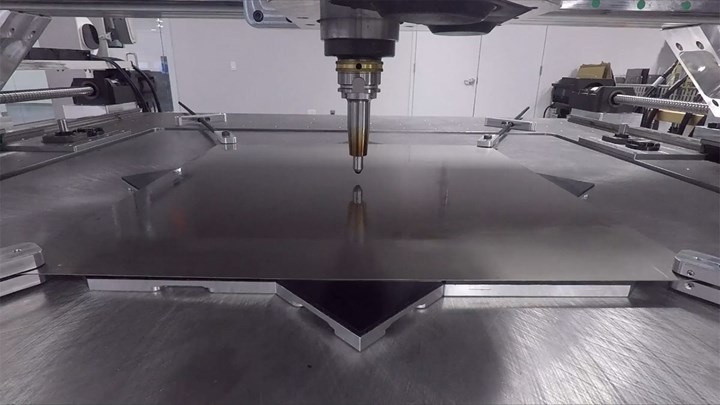With Digital Sheet Metal Forming System, Desktop Metal Is Going Beyond Additive
The additive manufacturing technology provider is introducing Digital Sheet Forming (DSF), a solution that requires no tooling.
Share
Read Next

A ceramic tool forms the sheet in a proprietary build zone, eliminating the need for stamping tooling. Photo Credit: Desktop Metal
In addition to showcasing updates to its Shop System metal binder jet 3D printer, Desktop Metal is displaying hundreds of metal and polymer parts and the systems that printed them across its two booths in the West Building (Booths 433103 and 432212). But the additive manufacturing company is also launching an all-new digital manufacturing system not based on 3D printing.
On display for the first time at IMTS 2022, the Figur G15 is a commercial platform for shaping sheet metal on demand, directly from a digital file. According to the company, Figur’s patent-pending Digital Sheet Forming (DSF) technology eliminates the need for traditional stamping presses, tools and dies, for sheet metal forming that is accessible, flexible and cost-effective, even at low volumes. The platform will enable users to supply unique metal products and prototypes without long wait times.
The Figur G15 has an XY forming area of 1,450 × 1,000 mm and can process forms ranging to 400 mm in the Z direction. A software-driven ceramic tool on an XY gantry forms the sheet with as much as 2,000 lbs of force in a proprietary build zone. It can process a variety of metals and sheet thicknesses, including steel up to 2.0 mm thick and aluminum up to 2.5 mm.
Related Content
-
3D Printed NASA Thrust Chamber Assembly Combines Two Metal Processes: The Cool Parts Show #71
Laser powder bed fusion and directed energy deposition combine for an integrated multimetal rocket propulsion system that will save cost and time for NASA. The Cool Parts Show visits NASA’s Marshall Space Flight Center.
-
VulcanForms Is Forging a New Model for Large-Scale Production (and It's More Than 3D Printing)
The MIT spinout leverages proprietary high-power laser powder bed fusion alongside machining in the context of digitized, cost-effective and “maniacally focused” production.
-
3D Printed Titanium Replaces Aluminum for Unmanned Aircraft Wing Splice: The Cool Parts Show #72
Rapid Plasma Deposition produces the near-net-shape preform for a newly designed wing splice for remotely piloted aircraft from General Atomics. The Cool Parts Show visits Norsk Titanium, where this part is made.

.jpg;width=70;height=70;mode=crop)










